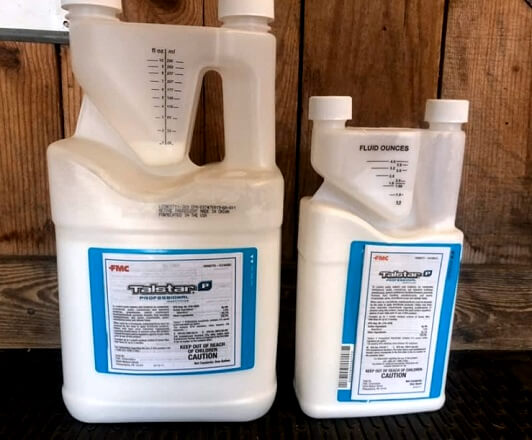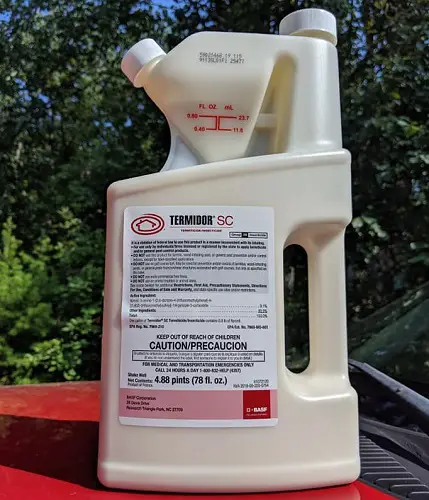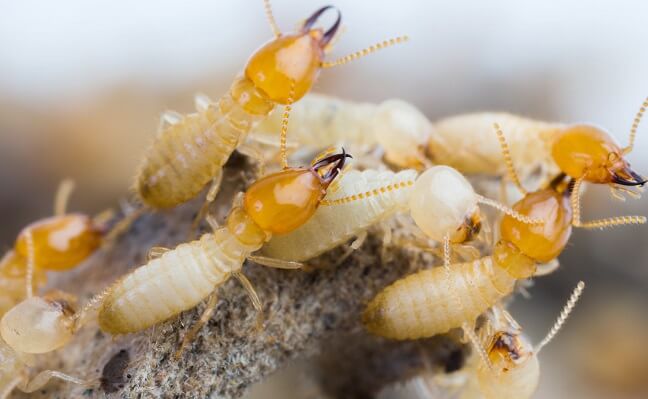Talstar P vs Termidor SC

The main difference between Talstar P and Termidor SC is that Talstar P is a broad-spectrum synthetic pyrethroid insecticide for pest control. At the same time, Termidor SC is a non-repellent termiticide primarily used for outdoor perimeter termite treatments.
Termidor Vs Talstar Table
Both insecticides are helpful and can destroy a severe infestation of general household pests.
Talstar P | Termidor |
Active ingredient Bifenthrin 7.9% | Active ingredient Fipronil 9.1% |
Kills On Contact | Slow Acting Termiticide |
Working System "Repellent" | Working System "Non-repellent" |
Can Be Used for Indoor and Outdoor Pest Control | Labeled for Outdoor Use Only |
Low Odor, No Staining, and No Plant Burn | It can Eliminate Almost Any Termite Problem in Less Than 90 Days |
Mixing Ratio Around 0.5 - 1 Oz. Per Gallon and Will Need to use 1 Gallons of Solution Per 1,000 Sq. Ft. | Mixing Ratio Around 0.80 Oz. Per Gallon of Water and Will Need to Use 1.5 Gallons of Solution per 1,000 Sq. Ft. |
It Keeps on Killing Pests for Over Three Months After You’ve Sprayed It | Protects Homes for up to 10 Years Making Around Termite Barrier |
Kill Over 75 Pests in and Around Homes Including Bed Bugs, Spiders, Mosquitoes, Cockroaches, Ticks, Fleas and Others | It Also Kills Termites,Ant, Asian Beetles, Cockroaches, Crickets, Earwigs, Millipedes, Silverfish, Spiders, Brown Dog Ticks and More |
Active Ingredients
The active ingredient in Talstar P is bifenthrin, making up 7.9% of the formulation. Bifenthrin is a synthetic pyrethroid that disrupts the nervous system of target pests on contact.
The active ingredient in Termidor SC is fipronil at 9.1% concentration. Fipronil is a phenylpyrazole that inhibits the GABA receptor complex in insects.

Main Use
As a broad-spectrum pyrethroid, Talstar P is primarily used for general pest control both indoors and outdoors. It controls over 75 insects, such as mosquitoes, spiders, roaches, and more.
In contrast, Termidor SC specializes in termite control as one of the leading termiticides on the market. It also controls other ant species.
Target Pests
Talstar P targets a wide variety of common pests with its broad-spectrum control, including spiders, scorpions, bed bugs, fleas, ticks, and others.
Termidor SC focuses on termites as its primary target but also lists ants, beetles, cockroaches, ticks, wasps, and other occasional invaders.
Using Guide
Talstar P can be used both indoors and outdoors for residential, commercial, and other applications. Termidor SC is designed for outdoor perimeter treatments only to control termites and other pests attempting structure entry.

Mixing Ratio
The mixing ratio for Talstar P is 0.5 to 1 oz per gallon of water, allowing flexibility based on pest levels. Termidor SC has a narrower dilution rate of 0.8 oz per gallon. Proper dilution is important for both pest control efficacy and safety.
Pet Safe
When applied as directed, both Termidor SC and Talstar P are considered pet-safe options. However, it’s still important to keep pets away during application until dry for safety. Always follow all label precautions.
Application
Talstar P can be applied in various indoor and outdoor settings. Termidor SC focuses outdoor applications on building perimeters and other termite entry points only.

Residual Activity
Once dry, Talstar P and Termidor SC provide long-lasting residual activity. Talstar P controls pests for up to 3 months, while Termidor SC provides termite colony control for at least three months.
Odor & Staining
A benefit shared by both Talstar P and Termidor SC is being odorless and non-staining when applied correctly. This makes them suitable for indoor and outdoor applications.
Repellent vs Non-Repellent
Talstar P is a repellent that makes areas unpleasant for pests to inhabit. Termidor SC is non-repellent, so termites cannot detect its presence, leading to colony elimination.
Application Equipment
Talstar P can be applied with standard sprayers like hose-end sprayers or tank sprayers. Termidor SC is best applied using specialized power sprayers, foam applicators, or rodding devices to achieve deep perimeter treatments.

Does Talstar Kill Termites?
Yes, Talstar P is labeled to treat for termites and is effective in controlling them. It works as a repellent, killing only those insects that come into contact with the treated area. However, it is important to note that Talstar P will only repel the termites, not kill the entire colony.
How Does Talstar P Work?
Talstar P is a liquid concentrate insecticide that contains bifenthrin, a synthetic pyrethroid. Pyrethroids disrupt an insect’s nervous system, causing a weakened state followed by death. Talstar P does not provide an instant knockdown of pests, instead, pests pick up the residual active ingredient by contact.
Our Observation
Based on the detailed comparison, it is evident that Talstar P and Termidor SC are effective pest control solutions with some key differences. Talstar P’s broad-spectrum insecticidal activity makes it more versatile for residential and commercial use.
In contrast, Termidor SC’s strength lies in its targeted control of termites and ants, making it ideal for dedicated perimeter treatments. While both provide long-lasting control, Termidor SC is limited to exterior use only.
Ultimately, matching the pesticide to the specific pest problem and treatment location is important for optimal results. Understanding these distinctions allows pest management professionals to make informed product selections.

